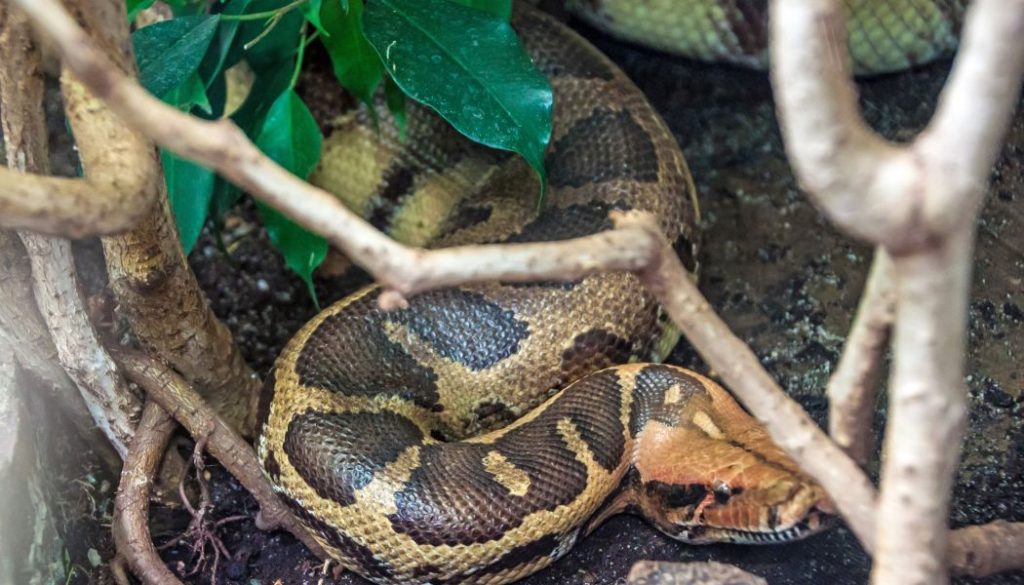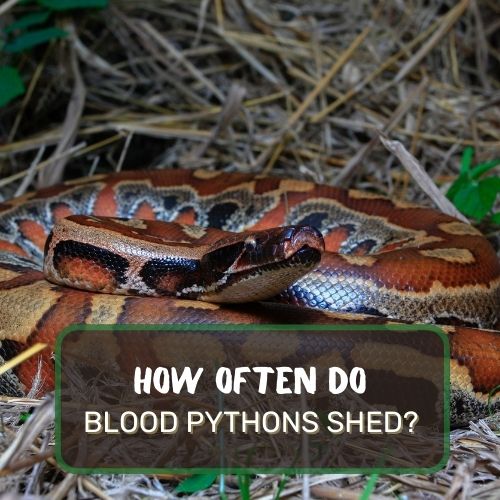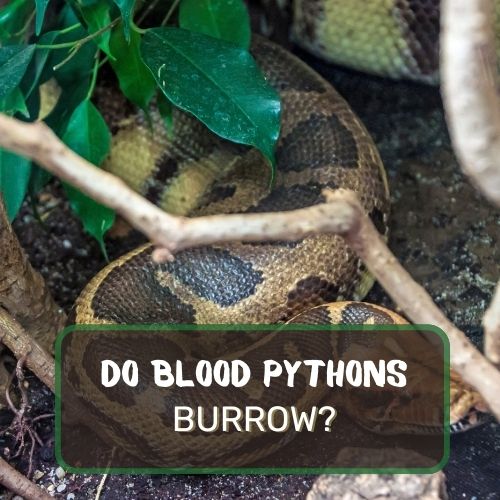Welcome to an intriguing exploration of the Blood Python, a species that blurs the lines between ground and canopy living. In this article, we delve into the fascinating world of Python brongersmai, addressing a common curiosity: Are Blood Pythons arboreal?
Blood Pythons are primarily terrestrial and are not naturally arboreal. They occasionally exhibit semi-arboreal behavior, such as climbing onto low branches, but they mostly dwell on the ground, especially due to their heavy, muscular build.
We’ll examine their natural behaviors in the wild, dissect their physical traits that could aid climbing, and discuss their semi-arboreal tendencies.
Additionally, we’ll cover essential aspects of Blood Python care, focusing on enclosure requirements and vertical space considerations.
Whether you’re a reptile enthusiast or just intrigued by these magnificent creatures, this article offers a comprehensive look at the lifestyle and habitat preferences of Blood Pythons.

Table of Contents
Exploring Their Natural Behavior in the Wild
When we ponder the question, “Are Blood Pythons Arboreal?”, it’s like unlocking a fascinating chapter from the book of nature. Blood Pythons, or Python brongersmai, are truly an enigma of the reptile world.
Originating from the lush landscapes of Southeast Asia, these pythons are often found lounging in tropical swamps and forests. But do these intriguing creatures take to the trees?
The short answer is: not typically. Blood Pythons are primarily ground-dwellers, skilled in the art of stealth on the forest floor. They are ambush predators, lying in wait for unsuspecting prey.
This doesn’t mean they can’t climb, though. In fact, they are known to occasionally explore elevated areas, but their heavy, muscular build is more suited to a life closer to the ground.
This semi-arboreal tendency is a nod to their adaptability, showing they can navigate different terrains when necessary.
Yet, their preference for the ground stems from more than just physical capability. It’s about survival. On the ground, they can expertly camouflage and strike with precision, demonstrating a perfect blend of patience and power.
This behavior paints a picture of a creature that is not just a product of evolution, but a master of its environment.
Physical Characteristics That Might Enable Them to Climb
The anatomy of the Blood Python is a testament to evolution’s craftsmanship. At first glance, their robust, thick-set bodies might not scream ‘climber’, but these snakes hold a few surprises up their scales. Let’s dissect their physical attributes to understand how they might maneuver up a tree.
First off, their size. Blood Pythons are impressively large, often reaching 4 to 6 feet in length, with females usually out-sizing the males. This size contributes to their ground-dwelling nature, as their hefty build isn’t ideal for the delicate balancing act required for tree climbing.
However, their muscular structure tells another story. These pythons possess incredible strength, particularly in their coils. This muscular power could, theoretically, aid in climbing, allowing them to anchor and hoist themselves up trunks and branches.
Moreover, their scales play a vital role. The underside of a Blood Python is equipped with specialized scales that could provide the grip needed for climbing. These scutes can help them maintain traction on rough surfaces, be it the bark of a tree or the uneven terrain of the forest floor.
Semi-Arboreal Tendencies and Preferences
Delving deeper into the arboreal question, it’s intriguing to note that Blood Pythons, while predominantly terrestrial, do exhibit some semi-arboreal tendencies. This doesn’t mean they’re swinging from branch to branch like their rainforest counterparts, but they do show an occasional inclination to explore above the ground level.
These semi-arboreal behaviors are more about opportunity than necessity. In their natural habitat, Blood Pythons may climb onto low-hanging branches or rocks, especially while young and more agile.
This activity could be driven by various factors – searching for prey, basking in a spot of sunlight, or even escaping waterlogged conditions in their swampy homes.
It’s a fascinating adaptation when you think about it. Their body, while heavy and not ideally built for climbing, still holds the potential for vertical exploration. This ability speaks volumes about their versatility and survival skills in the diverse ecosystems of Southeast Asia.
However, it’s important to remember that these instances are more the exception than the rule. Their true domain remains the forest floor, where their camouflage and hunting prowess truly shine.
Blood Python Enclosure Requirements
When it comes to recreating a slice of Southeast Asia for a Blood Python in captivity, understanding their natural habitat and behaviors is crucial. A well-designed enclosure not only ensures their physical well-being but also their psychological health.
First and foremost, size matters. These are sizable snakes, and their enclosure should reflect that. A minimum size of 4x2x2 feet is recommended for an adult Blood Python, but bigger is always better. This space allows them to move freely, stretch out, and engage in natural behaviors.
Next, let’s talk about vertical space. Although they are primarily ground-dwellers, providing some vertical enrichment can cater to their occasional climbing urges. This doesn’t mean tall trees or high branches, but rather some raised platforms or sturdy, low branches. This setup will enable them to exhibit those semi-arboreal behaviors in a safe and controlled environment.
The enclosure’s climate is another vital aspect. These snakes thrive in warm, humid conditions, reflecting their tropical origins. A temperature gradient from 75 to 90 degrees Fahrenheit, with a humidity level of 50-60%, is ideal. This can be achieved through heating pads, basking lights, and regular misting to maintain the humidity.
Lastly, don’t forget the substrate. A mixture of soils, mulches, or coconut husk can provide a comfortable and absorbent flooring, mimicking the forest floor and aiding in maintaining humidity levels.
Providing hiding spots and a water bowl large enough for soaking will complete the perfect home for a Blood Python, ensuring they feel secure and content in their captive environment.
More on Vertical Space Considerations for Semi-Arboreal Behavior
When tailoring an enclosure for a Blood Python, incorporating vertical space can significantly enhance their quality of life, acknowledging their sporadic semi-arboreal behavior.
This aspect of their enclosure design is about striking a balance – providing opportunities for climbing without overemphasizing an activity that isn’t a primary aspect of their lifestyle.
A few well-placed branches or sturdy, broad-leafed artificial plants can do the trick. These elements should be robust enough to support the python’s weight and offer them the occasional elevation.
This setup mimics the low-hanging branches they might encounter in the wild, offering a taste of arboreal life while keeping them safely grounded. It’s not just about physical exercise; this vertical enrichment can stimulate their natural curiosity and provide a change of scenery, crucial for their mental well-being.
Remember, though, the focus should still be on ground-level activities, with ample floor space for them to move and rest. The vertical elements are just an added feature, not the main attraction, reflecting the Blood Python’s true terrestrial nature.
Conclusion
As you’ve discovered, Blood Pythons are fascinating creatures, mostly terrestrial with some climbing abilities.
Their unique physical traits and occasional semi-arboreal tendencies reflect their adaptability. Remember, creating a comfortable habitat for them, considering both ground space and some vertical enrichment, is key to their well-being.
Your understanding and care can provide these magnificent snakes with a fulfilling life, mirroring their natural habitat.
Keep exploring and learning about these intriguing reptiles; your interest and dedication make a real difference in their world.
FAQ
Are blood pythons terrestrial?
Yes, Blood Pythons are primarily terrestrial. They spend most of their time on the ground in their natural habitats, which include forests and swamps in Southeast Asia.
Where do blood pythons live?
Blood Pythons are native to Southeast Asia, specifically found in regions like Thailand, Malaysia, and Indonesia. Their habitat ranges from tropical forests to swamps and marshes.
Do blood pythons climb?
While Blood Pythons are not naturally arboreal, they do exhibit some semi-arboreal tendencies. This means they may occasionally climb onto low-lying branches or rocks, especially in their juvenile stage. However, their primary habitat is on the ground.
What should Blood Python tank size be?
For a comfortable and humane habitat, an adult Blood Python’s tank should be at least 4x2x2 feet. However, larger enclosures are preferable to provide adequate space for movement and enrichment activities. This size allows for proper temperature gradients, hiding spots, and potentially some vertical elements for occasional climbing.




0 Comments